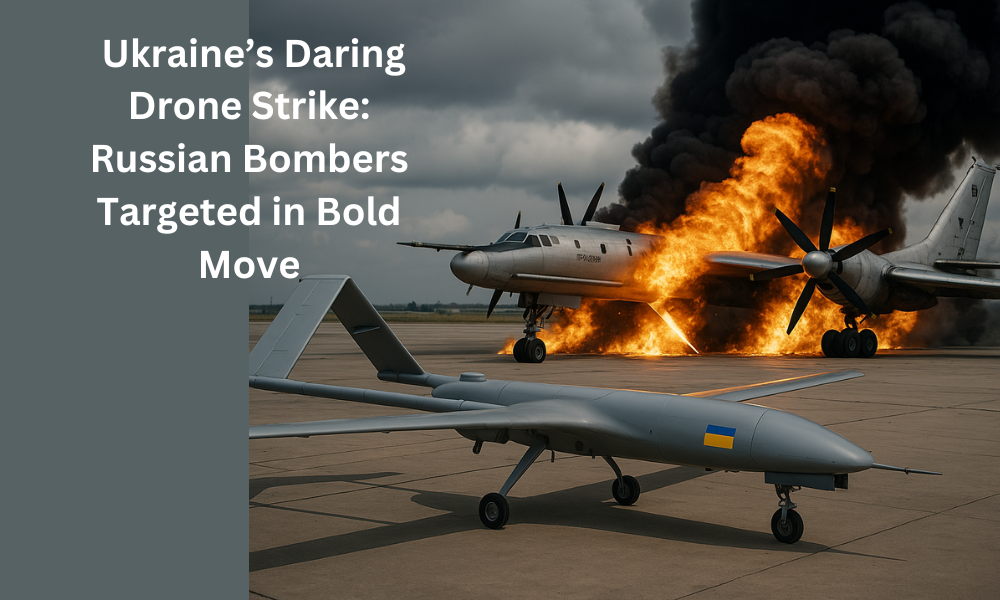Ukraine’s Daring Drone Strike: Russian Bombers Targeted in Bold Move

Ukraine has once again shown the breadth and tenacity of its drone warfare capabilities in a stunning escalation of contemporary warfare methods. According to Ukrainian and Western intelligence sources, Ukrainian drones targeted several Russian long-range aircraft based at airbases located deep within Russian territory in the early hours of Monday morning. The Drone Strike is a turning point in the continuing battle and demonstrates how the lines of battle have become increasingly hazy in the digital age of warfare.
Drone Strike: Drones Over Russian Soil
The purported strike targeted the Russian airbases of Engels and Mozdok, which are both used as strategic bomber launch sites. These planes, especially the Engels-based Tu-95 and Tu-160 bombers, are essential to Moscow’s long-range missile arsenal and have been instrumental in the launch of cruise missile attacks against Ukrainian cities.
Ukrainian military sources claim that dozens of drones were employed in a planned wave attack with the goal of overpowering Russian air defences. According to social media, satellite images of burnt airstrips and smoke coming from the base suggests that at least two bombers have suffered significant damage.
Although acknowledging the existence of drone assaults, Russia’s Defence Ministry minimised the damage, asserting that only minor damage was done and that the majority of the drones were intercepted. Independent researchers and defence specialists, however, believe the attack seems to have had a greater impact than Russian officials are prepared to acknowledge.
A New Phase of Warfare
Ukraine has previously attacked targets outside of its boundaries. A fleet of long-range drones, some of which can travel more than 1,000 kilometres, has been created by Kyiv from 2023. These drones, which are frequently created domestically using commercial components and some help from the West, are starting to pose a serious threat to Russia.
Once confined to surveillance and small-scale attacks, drone warfare has developed into a crucial element of contemporary strategy. And Ukraine has embraced this change with ingenuity and tenacity, even if it lacks a conventional air force to compete with Russia’s.
According to Mark Galeotti, a security specialist who focusses on Russian military matters, “this demonstrates that Ukraine is not only defending itself but has the capability to project power deep into Russian territory.” “It’s a strategic and symbolic blow.”
The Message Behind the Missiles
The attack’s timing is significant. As Western countries, particularly the US and Germany, have loosened limitations on Ukraine utilising their provided weaponry within Russian territory, it coincides with a renewed Ukrainian attempt to sabotage Russia’s air superiority and logistics.
Officials close to the Ukrainian defence ministry suggested that it was a “direct response” to recent missile assaults that killed people in Dnipro and Kharkiv, despite Ukraine not formally claiming credit.
The prevalence of this tit-for-tat dynamic is rising. However, in contrast to traditional retaliation, Ukraine’s drone strikes appear to be intended not only as a form of punishment but also as a means of strategically undermining Russia’s capacity to conduct war from a distance.
Russian Vulnerabilities Exposed
The event’s susceptibility to Russian military infrastructure may be its most significant lesson. Despite significant investments in air defence systems like the S-400, very inexpensive drones have regularly targeted Russian locations. It is important to not undervalue the psychological effects of these attacks.
The sense of distance between the battlefield and the average Russian is decreasing, particularly for those who reside close to military installations. It makes Russian commanders wonder about the efficacy of their multi-layered defence systems and operational security.
“If our long-range bombers are not safe in the heart of our territory, then what is?” said a former Russian officer, who is now an analyst, on Telegram.
The Road Ahead
The drone strike highlights a more general reality: trenches and tanks are no longer the only tools used in the conflict in Ukraine. Innovation, resiliency, and technology are at odds. Once dominated by manned aircraft, the sky is today rife with quiet, unmanned threats as both sides search for ways to gain the upper hand.
Drone Strike: Similar attacks might occur more frequently as additional aid from the West arrives and Ukraine’s drone capabilities develop quickly. It serves as a message to Russia that distance is no longer an excuse. For Ukraine, it demonstrates how contemporary instruments may provide an equitable playing field, even when against a more powerful foe.
One thing is certain as this war develops further: the boundaries no longer define the battlefield, and the rules of engagement are being revised one drone at a time.
